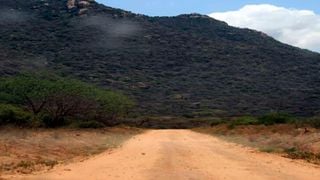
A murram road.
| File | Kanyiri Wahito | Nation Media GroupBusiness
Premium
Puzzle of SGR builder set to pocket Sh60m per kilometre for murram road
Kenyans will pay a Chinese firm that built the Standard Gauge Railway Sh60 million to lay murram on each kilometre of a road linking Lamu and Garissa through Ijara, a unit cost higher than that for rural roads and even tarmacked ones.
State-owned China Communications Construction Company (CCCC), in a joint venture with engineering firm Territorial Works Ltd, was awarded a Sh27.29 billion tender by the Kenya National Highways Authority (Kenha) in April to upgrade the Lamu-Ijara-Garissa road to an all-weather gravel road.
The high cost of the project, which is meant to support the Lapsset corridor, comes as concerns rise about the high cost of road projects. And it has earned Transport Cabinet Secretary James Macharia a date with the Senate’s Committee on Roads and Transportation.
Nandi Senator Samson Cherarkey wants Mr Macharia to explain how the tender for the project, to be completed in 2023, was awarded.
Lawmakers were to speak to the CS via video link on Thursday morning but that did not happen, and Kiambu Senator Kimani Wamatangi, who chairs the committee, did not respond to the Nation’s queries on why the sitting failed.
The murram road networks will cover 453km, with the main stretch from Lamu to Garissa through Ijara covering 257km, the Hindi-Bodhei-Basuba-Kiunga section 113km and the Ijara-Sangailu-Hulugho part 83km.
Open up region
Once completed, the roads will open up the volatile region by facilitating the transport of goods between Lamu, southern Ethiopia and Somalia and improving security.
But the steep cost of the project is puzzling, given that there will be no high land compensation costs and huge provisions for relocating critical infrastructure utilities, factors that the ministry usually blames for bloated costs of roads projects.
The road is among those that the Treasury expects the State Department of Infrastructure to give priority to in the current financial year, even as high building and maintenance costs for such roads eat up ever larger chunks of taxpayer money.
“The Department will prioritise the completion of Nairobi Expressway, James Gichuru-Rironi Road, Construction of Mombasa Port Area Road Development Project, upgrading of Lamu-Ijara-Garissa road to all-weather standard, Mau Mau roads, Kenol-Sagana-Marua Project, completion of Nairobi Western Bypass,” Treasury said in the budget statement.
But pressure from international lenders has forced the government to roll out a land value index. It is expected to cut exorbitant land compensation claims by landowners who make way for government projects and significantly reduce costs.
The 2019 Land Valuation Amendment Act provides for the development of a land value index for all counties, but only six – Nakuru, Narok, Kericho, Mombasa, Bomet and Kisumu – have developed such indices.
“The development of a valuation index which is reviewed regularly will inform the valid market price when the government acquires land for its development projects,” the World Bank said in June after wiring its latest Sh80.9 billion loan to Nairobi.
“It will also mitigate the risk that local communities are exploited, as it allows communities to know the value of their properties, a strongly pro-poor measure.”
The government has also adopted public-private partnerships for mega road projects, alleviating pressure on taxpayers, at least in the short-term.
These include the Sh59 billion Nairobi Expressway and the Sh160 billion Rironi-Mau Summit dual carriageway, which are being built in partnership with private entities, with costs to be recovered over time.





